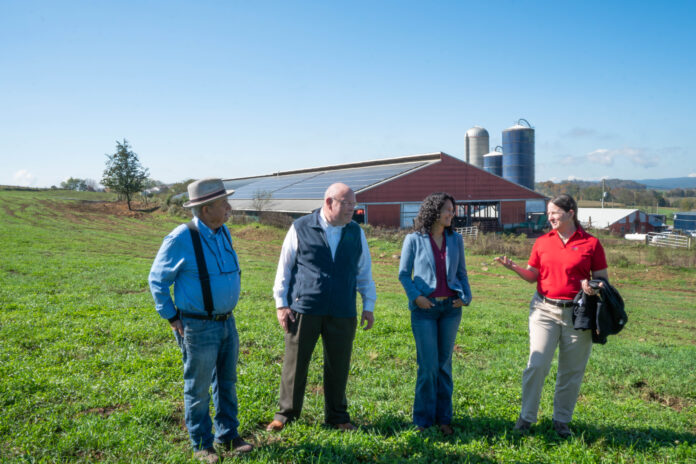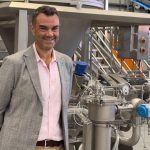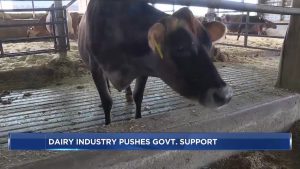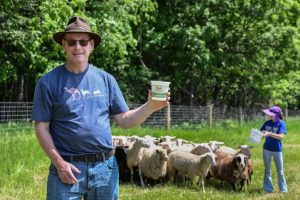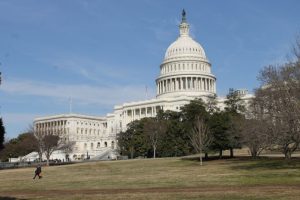
Solar doesn’t belong on farmland, but it definitely belongs on farms, according to Rich Perkoski, owner of Main Street Milk Farm, in Somerset County.
Perkoski recently installed solar panels on the rooftop of his barn through the Rural Energy for America Program, REAP. The switch has saved him thousands of dollars on his monthly electric bill, which he shared during a tour of his farm Oct. 3 with U.S. Department of Agriculture Deputy Secretary Xochitl Torres Small.
During the farm tour, Torres Small announced another $104 million investment available through REAP to support over 300 clean energy projects in 34 states.
“As drivers of our economy, farmers and rural business owners deserve affordable energy,” said Torres Small in a statement. “REAP loans and grants … will lower energy costs for farmers and small business and help them expand their operations, all while tackling climate change.”

Savings
Perkoski owns 590 acres in Somerset, Pennsylvania where he runs a dairy operation with 300 cows — 220 milking cows — and five employees. He also grows corn and hay.
One of Perkoski’s biggest expenses has been his monthly electric bill. Dairy farms require a lot of electricity to operate. The cows need 24/7 lighting or else they won’t milk properly, Perkoski said. Alongside constant lighting, electricity is needed for heating, milking and running the vacuum pump.
Since Perkoski installed solar panels about four months ago, his electric bill went from $2,500 a month to roughly $75. Main Street Milk received $110,000 from the USDA’s REAP fund and invested $174,000 itself to install 321 solar panels.
Currently, the solar panels are producing more than the farm requires and, as a result, the energy the farm doesn’t use is channeled back into the grid. Perkoski receives credits from his electric company for this excess energy he supplies which he can use in the months his solar panels don’t operate at full captivity.
According to Envinity — a solar energy company based out of Centre County, Pennsylvania, that installed Perkoski’s panels — the solar panels produce energy at full capacity eight months out of the year. During the four winter months, the panels still produce energy but at a lower volume.
On these cloudy days, the farm uses electricity from the grid, which Perkoski can take out of his acquired credits or pay for at a reduced cost.

REAP program
The REAP program was created through the 2008 Farm Bill, which provided $255 million in funding for energy efficiency upgrades for rural, small businesses and agricultural producers. Then, in the 2014 Farm Bill, the funding increased to $435 million and a mandatory funding baseline of $50 million annually was established for REAP.
The Biden Administration’s Inflation Reduction, passed in August 2022, has invested more than $2.3 billion into the REAP program — the biggest investment since its inception.
According to Cam Willison, manager of commercial solar development at Envinty, the company has seen a “huge exponential growth” in solar installations since the passage of the Inflation Reduction Act.
The USDA’s most recent investment on Oct. 3 will go toward installing wind, solar, geothermal, hydropower and other energy efficiency projects across the country.
Schrack Farms Resources LP, an 11th-generation farm based out of Clinton County, Pennsylvania, will get about $479,000 to replace the engine to its anaerobic digester. The project is estimated to produce 2.7 million kilowatt hours per year, enough energy to power 252 homes, according to the USDA.
Alongside providing producers with funding, REAP Technical Assistance is available in each region to assist farmers with applying for the program, finding the right companies for installation and more. Funding is limited and the deadline to apply in fiscal year 2024 is Dec. 31.
A solar journey
This wasn’t the first time Perkoski installed solar panels; his journey with solar started 15 years ago on his farm in Lincoln Borough, Pennsylvania.
He installed 200 panels on top of his home in Lincoln Borough where he runs his company Port Vue Plumbing Inc. and breeds and raises calf cows. The solar energy created on the property powers his home and farming operations.
Then, in 2021, Perkoski and his men began to install 8,000 ground-mounted solar panels on 48 acres of former strip mine land in Jefferson Hills, Pennsylvania. The panels at the solar farm came online about nine months ago and the energy produced is sold to Duquesne Light Company.
For Perkoski, there was never any hesitation about using solar panels, but where the panels go is important.
“As long as I don’t put them on the field where I got pasture, you can’t ruin fields to put in solar,” Perkoski said. “The easiest way is to put it on farmland.”
Although he’s only used REAP to install solar panels at Main Street Milk Farm, Perkoski hopes to implement other cost-saving solutions like electric heating. The future appears bright for the farm and solar panels are just the start.
For more information on REAP or to apply, visit rd.usda.gov/programs-services/energy-programs/rural-energy-america-program-renewable-energy-systems-energy-efficiency-improvement-guaranteed-loans.
You can now read the most important #news on #eDairyNews #Whatsapp channels!!!
🇺🇸 eDairy News INGLÊS: https://whatsapp.com/channel/0029VaKsjzGDTkJyIN6hcP1K
